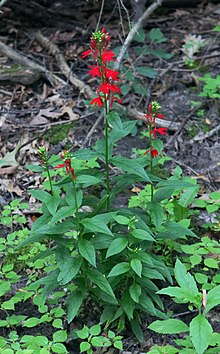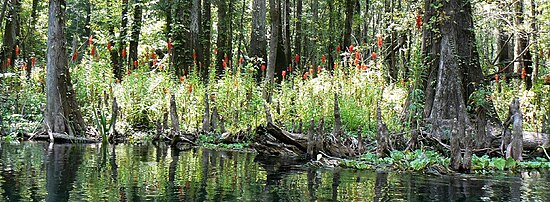
Kalmia latifolia, the mountain laurel, calico-bush, or spoonwood, is a species of flowering plant in the heath family Ericaceae, that is native to the eastern United States. Its range stretches from southern Maine south to northern Florida, and west to Indiana and Louisiana. Mountain laurel is the state flower of Connecticut and Pennsylvania. It is the namesake of Laurel County in Kentucky, the city of Laurel, Mississippi, and the Laurel Highlands in southwestern Pennsylvania.

Justicia brandegeeana, the Mexican shrimp plant, shrimp plant or false hop, is an evergreen shrub in the genus Justicia of the acanthus family Acanthaceae, native to Mexico, and also naturalized in Florida.
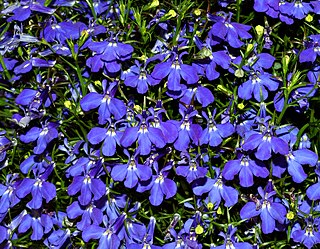
Lobelia is a genus of flowering plants in the family Campanulaceae comprising 415 species, with a subcosmopolitan distribution primarily in tropical to warm temperate regions of the world, a few species extending into cooler temperate regions. They are known generally as lobelias.

Heliconia is a genus of flowering plants in the monotypic family Heliconiaceae. Most of the 194 known species are native to the tropical Americas, but a few are indigenous to certain islands of the western Pacific and Maluku in Indonesia. Many species of Heliconia are found in the tropical forests of these regions. Most species are listed as either vulnerable or data deficient by the IUCN Red List of threatened species. Several species are widely cultivated as ornamentals, and a few are naturalized in Florida, Gambia, and Thailand.

The family Campanulaceae, of the order Asterales, contains nearly 2400 species in 84 genera of herbaceous plants, shrubs, and rarely small trees, often with milky sap. Among them are several familiar garden plants belonging to the genera Campanula (bellflower), Lobelia, and Platycodon (balloonflower). Campanula rapunculus and Codonopsis lanceolata are eaten as vegetables. Lobelia inflata, L. siphilitica and L. tupa and others have been used as medicinal plants. Campanula rapunculoides may be a troublesome weed, particularly in gardens, while Legousia spp. may occur in arable fields.

Silene virginica, the fire pink, is a wildflower in the pink family, Caryophyllaceae. It is known for its distinct brilliant red flowers. Fire pink begins blooming in late spring and continuing throughout the summer. It is sometimes grown in wildflower, shade, and rock gardens.
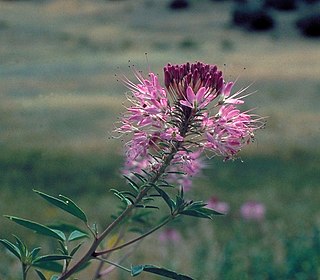
Cleomella serrulata, commonly known as Rocky Mountain beeplant/beeweed, stinking-clover, bee spider-flower, skunk weed, Navajo spinach, and guaco, is a species of annual plant in the genus Cleomella. Many species of insects are attracted to it, especially bees, which helps in the pollination of nearby plants. It is native to southern Canada and the western and central United States. The plant has often been used for food, to make dyes for paint, and as a treatment in traditional medicine.

Echinodorus cordifolius, the spade-leaf sword or creeping burhead, is a species of aquatic plants in the Alismatales. It is native to Mexico, the West Indies, Central America, South America and the southeastern United States.
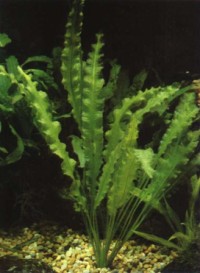
Aponogeton crispus, the crinkled aponogeton or ruffled sword plant, is an aquatic plant species in the family Aponogetonaceae.

Rhododendron calendulaceum, the flame azalea, is a species of Rhododendron. It is a deciduous shrub that grows up to 120–450 cm tall. This species of Rhododendron is native to the Appalachian Mountains in the eastern United States, ranging from southern Pennsylvania and Ohio to northern Georgia. It may be extirpated from Pennsylvania and Alabama. It occurs naturally in mixed deciduous forests and is typically found in woodland slopes and mountain balds in the Appalachians, where it prefers dry and rocky mountain woods. The inflorescences of Rhododendron calendulaceum are visited by many animals such as bees, butterflies, hummingbirds and small mammals. It is a popular cultivated plant due to its bright yellow, orange or red flowers.

Erythranthe cardinalis, the scarlet monkeyflower, is a flowering perennial in the family Phrymaceae. Together with other species in Mimulus section Erythranthe, it serves as a model system for studying pollinator-based reproductive isolation. It was formerly known as Mimulus cardinalis.

Lonicera sempervirens is a flowering plant species of honeysuckle vine native to the eastern United States which is known for its reddish flowers.

Lobelia siphilitica, the great blue lobelia, great lobelia, or blue cardinal flower, is a plant species within the family Campanulaceae. It is an herbaceous perennial dicot native to eastern and central Canada and United States. There are two recognized varieties of Lobelia siphilitica, var. siphilitica and var. ludoviciana. Blooming from August to October, it is short-lived, lasting only for a few years.

Dracaena fragrans, is a flowering plant species that is native throughout tropical Africa, from Sudan south to Mozambique, west to Côte d'Ivoire and southwest to Angola, growing in upland regions at 600–2,250 m (1,970–7,380 ft) altitude. It is also known as striped dracaena, compact dracaena, and corn plant.
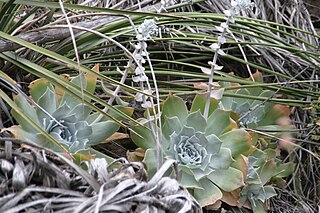
Dudleya pulverulenta is a species of perennial succulent plant known by the common names chalk lettuce, chalk dudleya, and chalk liveforever. It is one of the largest Dudleya, with a silvery, waxy rosette that may greatly contrast with its habitat. It is also regarded as one of the most distinctive members of the Dudleya, with one of the most specialized inflorescences in the genus, adapted to hummingbird pollination through its red pendent flowers, the longest corolla, and the highest nectar output. Dudleya pulverulenta has the largest range of all Dudleya, over 1,000 kilometres (620 mi), being found from southern Monterey County in California to the Sierra de San Borja in southern Baja California. It is closely related to Dudleya arizonica, a smaller desert species that tends to lack the specialized floral traits, and Dudleya anthonyi, which differs in a few morphological traits and is restricted to the San Quintín Volcanic Field.

Lobelia kalmii is a species of flowering plant with a distribution primarily across Canada and the northern United States in temperate and boreal regions. It was formerly known as Lobelia strictiflora (Rydb.) It is commonly known as Kalm's lobelia, Ontario lobelia and Brook lobelia.
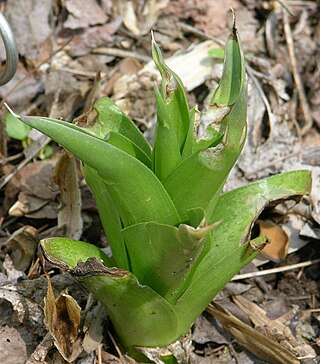
Agave virginica, synonym Manfreda virginica, commonly known as the false aloe, rattlesnake master, American aloe, Virginia agave, and eastern agave, is a species of agave. It is native to the central and southeastern United States and northeastern Mexico, where it is found in prairies, upland rocky glades, and sandy open woods.
Iris nelsonii is a species in the genus Iris, it is also in the subgenus Limniris and in the series hexagonae. It is a rhizomatous perennial, from northern America. It has long drooping, grass-like leaves, tall stems, 10 red-purple flowers.
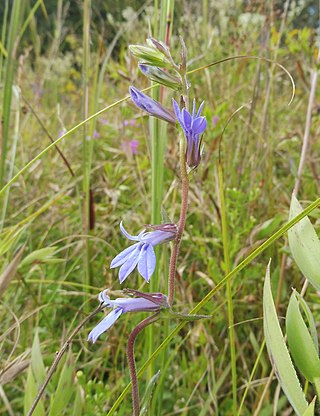
Lobelia puberula, or downy lobelia, is a perennial herbaceous wildflower in the Bellflower family (Campanulaceae) native to eastern and south central United States. It is the most common blue-flowered Lobelia in the Southeast. It grows in mesic to hydric (moist) habitats in sun or partial shade.

Erythranthe, the monkey-flowers and musk-flowers, is a diverse plant genus with more than 120 members in the family Phrymaceae. Erythranthe was originally described as a separate genus, then generally regarded as a section within the genus Mimulus, and recently returned to generic rank. Mimulus sect. Diplacus was segregated from Mimulus as a separate genus at the same time. Mimulus remains as a small genus of eastern North America and the Southern Hemisphere. Molecular data show Erythranthe and Diplacus to be distinct evolutionary lines that are distinct from Mimulus as strictly defined, although this nomenclature is controversial.



